Melting, Crystallization, and In Vitro Digestion Properties of Fats Containing Stearoyl-Rich Triacylglycerols
Abstract
1. Introduction
2. Results and Discussion
2.1. Fatty Acid Composition
2.2. Acylglycerol and TAG Composition
2.3. Melting and Crystallization Behaviors
2.4. Solid Fat Index (SFI)
2.5. Crystal Microstructure
2.6. Digestibility of SSO-Rich and OSO-Rich Fats Determined with In Vitro pH-Stat Model
2.7. Digestibility of SSO-Rich and OSO-Rich Fats Determined Using In Vitro Multi-Step Digestion Model
2.8. Profiles of the Released FFAs of SSO-Rich and OSO-Rich Fats during In Vitro Multi-Step Digestion Model
3. Materials and Methods
3.1. Materials
3.2. Synthesis of SSO-Rich and SOS-Rich Fats
3.3. Acylglycerol Composition
3.4. TAG Composition
3.5. FA Composition
3.6. Melting and Crystallization Behaviors and SFI
3.7. Crystal Morphology
3.8. In Vitro Digestion with pH-Stat Model
3.9. In Vitro Multi-Step Digestion Model
3.10. Statistical Analysis
4. Conclusions
Author Contributions
Funding
Institutional Review Board Statement
Informed Consent Statement
Data Availability Statement
Conflicts of Interest
References
- Karupaiah, T.; Sundram, K. Effects of stereospecific positioning of fatty acids in triacylglycerol structures in native and randomized fats: A review of their nutritional implications. Nutr. Metab. 2007, 4, 16. [Google Scholar] [CrossRef]
- Michalski, M.C.; Genot, C.; Gayet, C.; Lopez, C.; Fine, F.; Joffre, F.; Vendeuvre, J.L.; Bouvier, J.; Chardigny, J.M.; Raynal-Ljutovac, K. Multiscale structures of lipid in foods as parameters affecting fatty acid bioavailability and lipid metabolism. Prog. Lipid Res. 2013, 52, 354–373. [Google Scholar] [CrossRef]
- Mattson, F.H.; Volpenhein, R.A. The Digestion and Absorption of Triglycerides. J. Biol. Chem. 1964, 239, 2772–2777. [Google Scholar] [CrossRef]
- Yang, L.Y.; Kuksis, A. Apparent convergence (at 2-monoacylglycerol level) of phosphatidic acid and 2-monoacylglycerol pathways of synthesis of chylomicron triacylglycerols. J. Lipid Res. 1991, 32, 1173–1186. [Google Scholar] [CrossRef]
- Hegsted, D.M.; McGandy, R.B.; Myers, M.L.; Stare, F.J. Quantitative effects of dietary fat on serum cholesterol in man. Am. J. Clin. Nutr. 1965, 17, 281–295. [Google Scholar] [CrossRef] [PubMed]
- Yu, S.; Derr, J.; Etherton, T.D.; Kris-Etherton, P.M. Plasma cholesterol-predictive equations demonstrate that stearic acid is neutral and monounsaturated fatty acids are hypocholesterolemic. Am. J. Clin. Nutr. 1995, 61, 1129–1139. [Google Scholar] [CrossRef] [PubMed]
- Mensink, R.P.; Zock, P.L.; Kester, A.D.M.; Katan, M.B. Effects of dietary fatty acids and carbohydrates on the ratio of serum total to HDL cholesterol and on serum lipids and apolipoproteins: A meta-analysis of 60 controlled trials. Am. J. Clin. Nutr. 2003, 77, 1146–1155. [Google Scholar] [CrossRef] [PubMed]
- Silva, T.J.; Barrera-Arellano, D.; Ribeiro, A.P.B. Margarines: Historical approach, technological aspects, nutritional profile, and global trends. Food. Res. Int. 2021, 147, 110486. [Google Scholar] [CrossRef] [PubMed]
- Aro, A.; Jauhiainen, M.; Partanen, R.; Salminen, I.; Mutanen, M. Stearic acid, trans fatty acids, and dairy fat: Effects on serum and lipoprotein lipids, apolipoproteins, lipoprotein(a), and lipid transfer proteins in healthy subjects. Am. J. Clin. Nutr. 1997, 65, 1419–1426. [Google Scholar] [CrossRef] [PubMed]
- USDA/HHS. Dietary Guidelines for Americans, 7th ed.; Government Printing Office: Washington, DC, USA, 2010. Available online: https://health.gov/dietaryguidelines/2010. (accessed on 24 July 2017).
- Vega-Lo´pez, S.; Ausman, L.M.; Jalbert, S.M.; Erkkila, A.T.; Lichtenstein, A.H. Palm and partially hydrogenated soybean oils adversely alter lipoprotein profiles compared with soybean and canola oils in moderately hyperlipidemic subjects. Am. J. Clin. Nutr. 2006, 84, 54–62. [Google Scholar] [CrossRef]
- Lee, J.H.; Akoh, C.C.; Lee, K.T. Physical properties of trans-free bakery shortening produced by lipase-catalyzed interesterification. J. Am. Oil Chem. Soc. 2008, 85, 1–11. [Google Scholar] [CrossRef]
- Li, D.; Adhikari, P.; Shin, J.A.; Lee, J.H.; Kim, Y.K.; Zhu, X.M.; Hu, J.N.; Jin, J.; Akoh, C.C.; Lee, K.T. Lipase-catalyzed interesterification of high oleic sunflower oil and fully hydrogenated soybean oil comparison of batch and continuous reactor for production of zero trans shortening fats. LWT-Food Sci. Technol. 2010, 43, 458–464. [Google Scholar] [CrossRef]
- Kim, J.Y.; Lee, K.T. Enzymatic interesterification and melting characteristic for asymmetric 1,2-distearoyl-3-oleoyl-rac-glycerol triacylglycerol enriched product. J. Korean Soc. Food Sci. Nutr. 2014, 43, 93–101. [Google Scholar] [CrossRef]
- Finley, J.W.; Klemann, L.P.; Leveille, G.A.; Otterburn, M.S.; Walchak, C.G. Caloric availability of SALATRIM in rats and humans. J. Agric. Food Chem. 1994, 42, 495–499. [Google Scholar] [CrossRef]
- Vučić, V.; Arsić, A.; Petrović, S.; Milanović, S.; Gurinović, M.; Glibetić, M. Trans fatty acid content in Serbian margarines: Urgent need for legislative changes and consumer information. Food Chem. 2015, 185, 437–440. [Google Scholar] [CrossRef]
- Arishima, T.; Tachibana, N.; Kojima, M.; Takamatsu, K.; Katsumi, I. Screening of resistant triacylglycerols to the pancreatic lipase and their potentialities as a digestive retardant. J. Food Lipids. 2009, 16, 72–88. [Google Scholar] [CrossRef]
- Sahri, M.M.; Dian, N.L. Formulation of trans-free and low saturated margarine. J. Oil Palm Res. 2011, 23, 958–967. [Google Scholar]
- Talbot, G. Compound coatings. In Technology of Coated and Filled Chocolate, Confectionery and Bakery Products; Talbot, G., Ed.; Woodhead Publishing: Cambridge, UK, 2009; pp. 80–99. [Google Scholar]
- Humphrey, K.L.; Moquin, P.H.L.; Narine, S.S. Phase behavior of a binary lipid shortening system: From molecules to rheology. J. Am. Oil Chem. Soc. 2003, 80, 1175–1182. [Google Scholar] [CrossRef]
- Chang, H.J.; Lee, J.H. Regiospecific positioning of palmitic acid in triacylglycerol structure of enzymatically modified lipids affects physicochemical and in vitro digestion properties. Molecules 2021, 26, 4015. [Google Scholar] [CrossRef]
- Mattson, F.H.; Nolen, G.A.; Webb, M.R. The absorbability by rats of various triglycerides of stearic and oleic acid and the effect of dietary calcium and magnesium. J. Nutr. 1979, 109, 1682–1687. [Google Scholar] [CrossRef] [PubMed]
- Livesey, G. The absorption of stearic acid from triacylglycerols: An inquiry and analysis. Nutr. Res. Rev. 2000, 13, 185–214. [Google Scholar] [CrossRef] [PubMed][Green Version]
- Small, D.M. The effects of glyceride structure on absorption and metabolism. Ann. Rev. Nutr. 1991, 11, 413–434. [Google Scholar] [CrossRef] [PubMed]
- Brownlee, I.; Forster, D.; Wilcox, M.; Dettmar, P.; Seal, C.; Pearson, J. Physiological parameters governing the action of pancreatic lipase. Nutr. Res. Rev. 2010, 23, 146–154. [Google Scholar] [CrossRef] [PubMed]
- Guillén, M.D.; Uriatre, P.S. Study by 1H NMR spectroscopy of the evolution of extra virgin olive oil composition submitted to frying temperature in an industrial fryer for a prolonged period of time. Food Chem. 2012, 134, 162–172. [Google Scholar] [CrossRef]
- AOCS. Official Method and Recommended Practices, 6th ed.; American Oil Chemists’ Society: Champaign, IL, USA, 2009; pp. 1–25. [Google Scholar]
- Versantvoort, C.H.M.; Oomen, A.G.; de Kamp, E.V.; Rompelberg, C.J.M.; Sips, A.J.A.M. Applicability of an in vitro digestion model in assessing the bioaccessibility of mycotoxins from food. Food Chem. Toxicol. 2005, 43, 31–40. [Google Scholar] [CrossRef]
- Ji, C.; Shin, J.A.; Hong, S.T.; Lee, K.T. In vitro study for lipolysis of soybean oil, pomegranate oil, and their blended and interesterified oils under a pH-Stat model and a simulated model of small intestinal digestion. Nutrients 2019, 11, 678. [Google Scholar] [CrossRef] [PubMed]
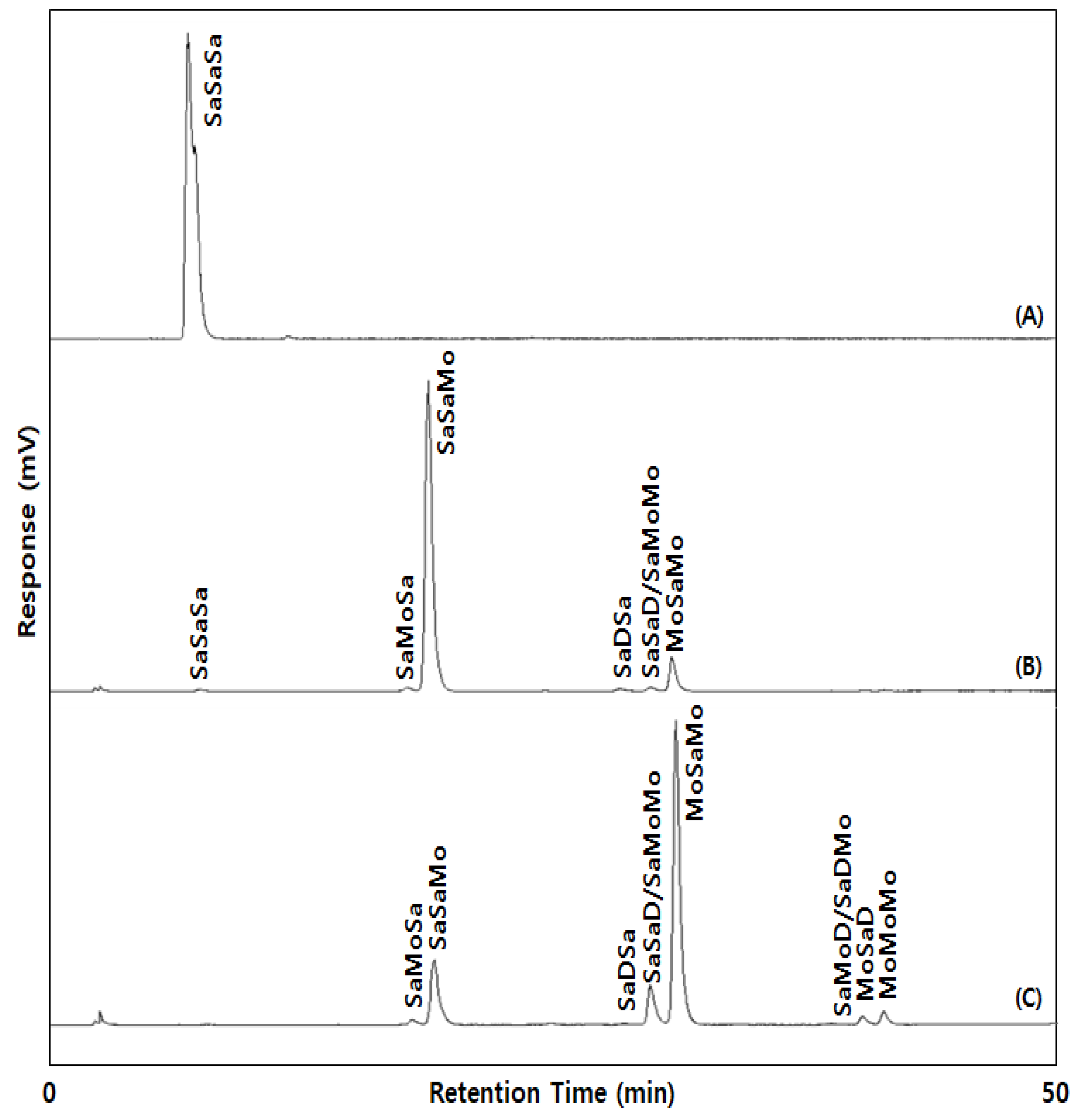
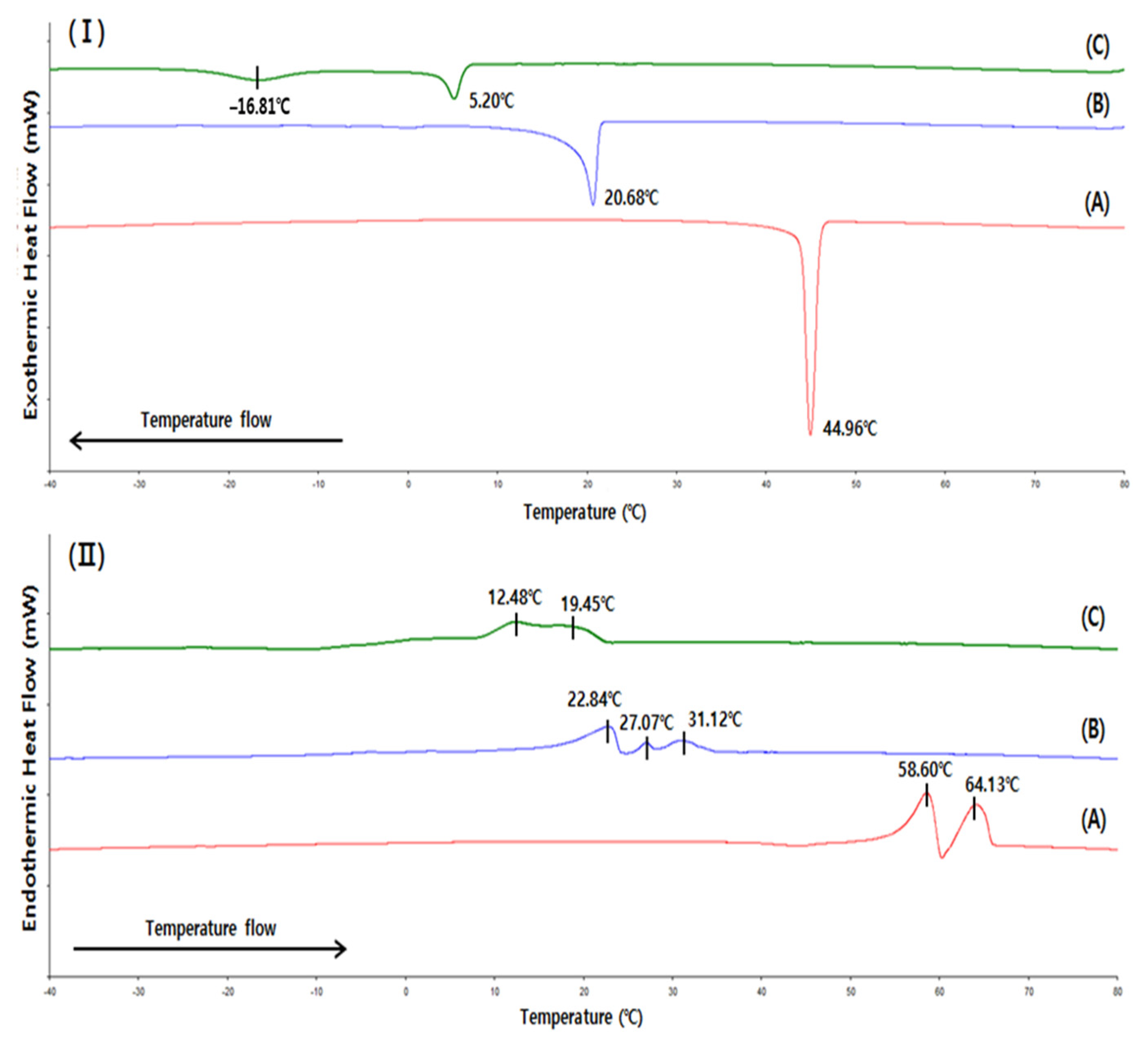
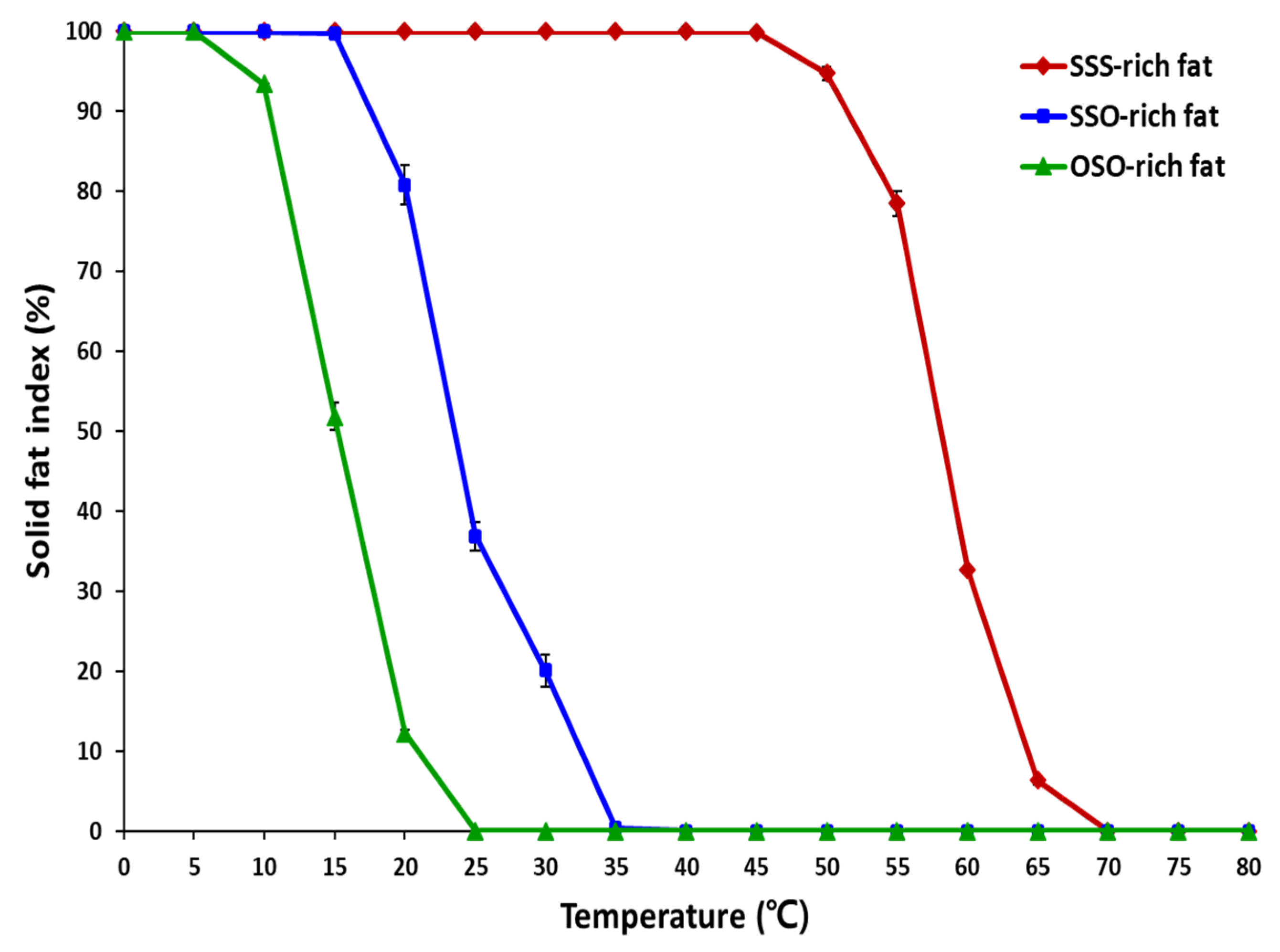
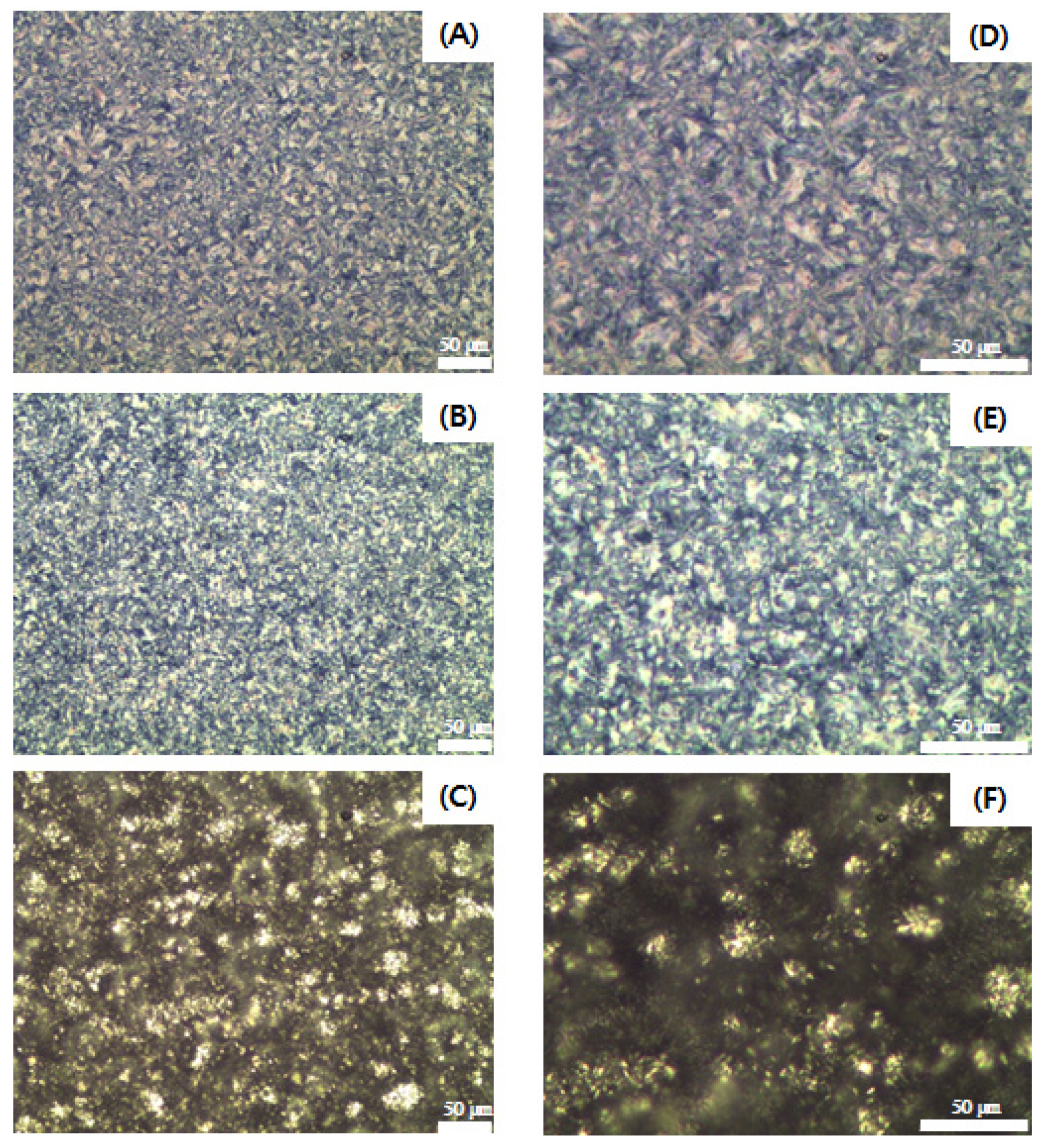
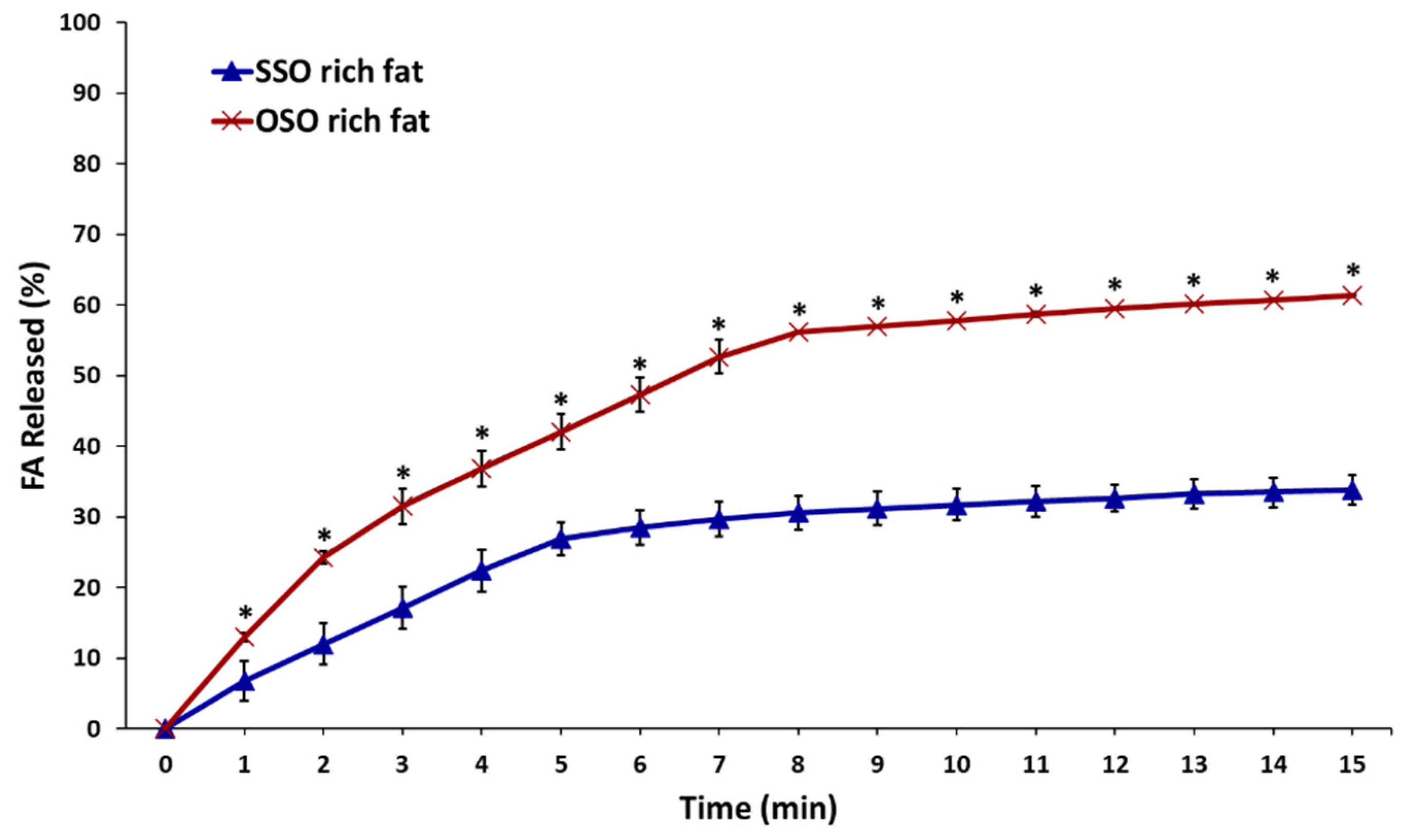
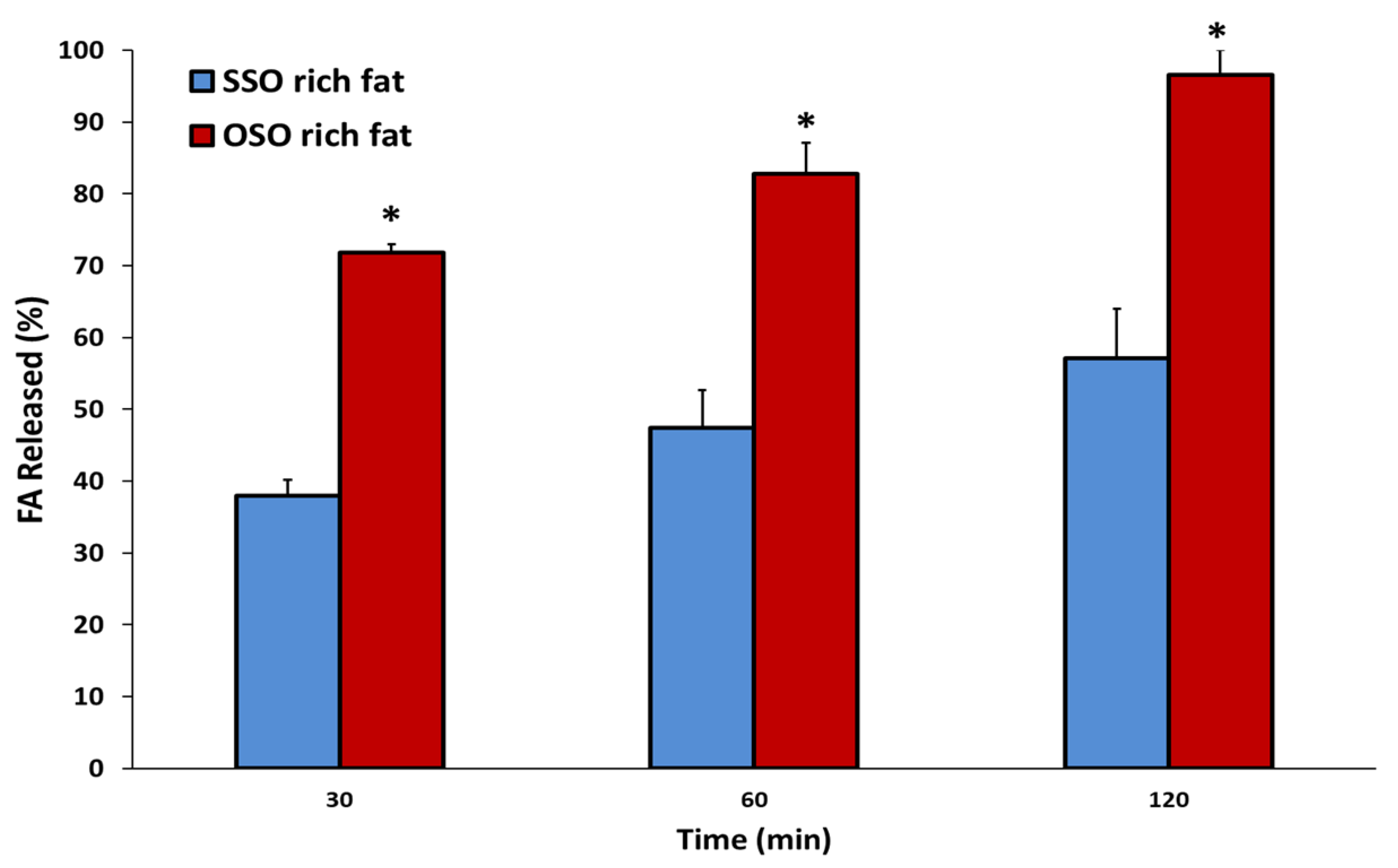
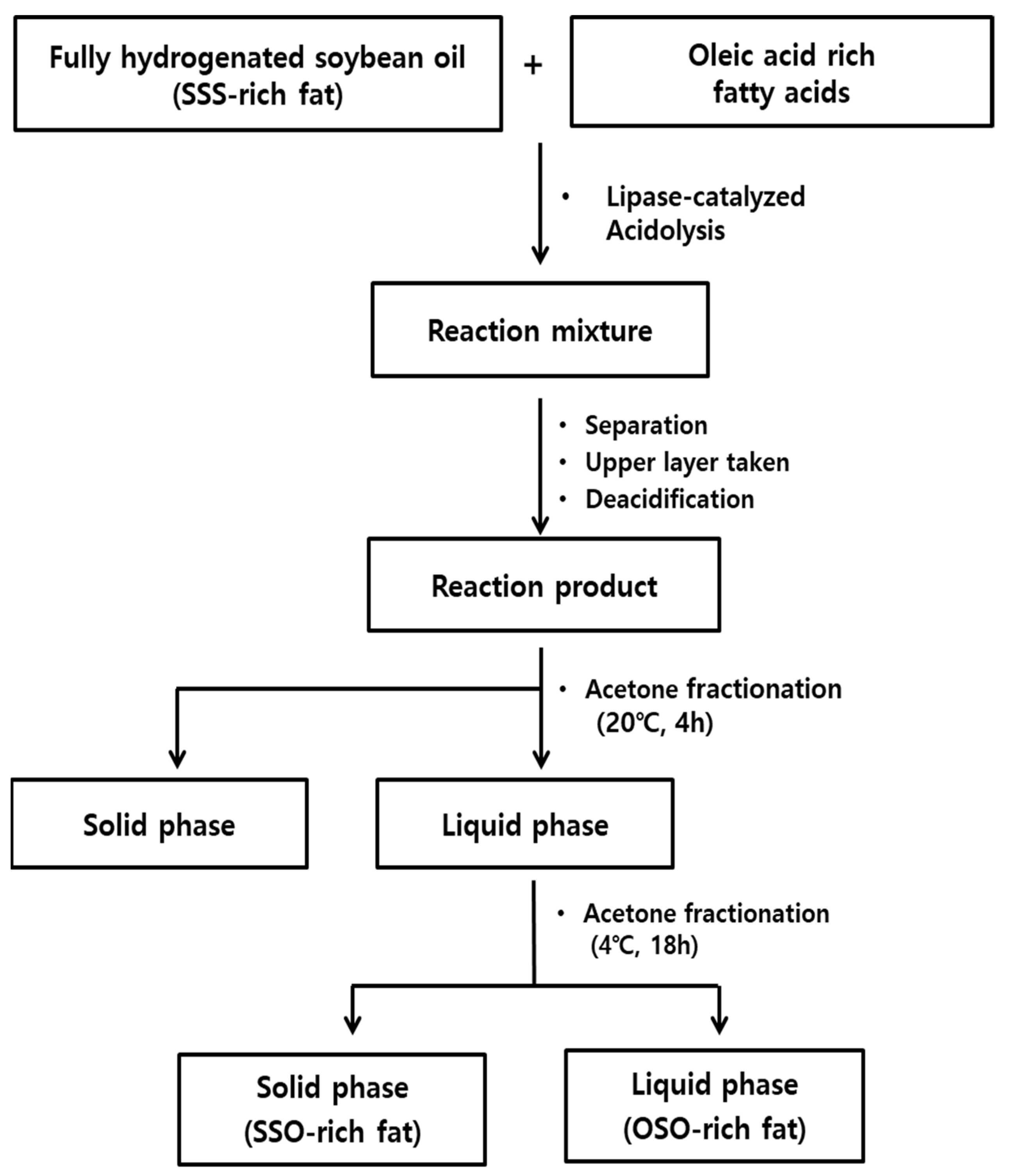
| Fatty Acid (% of Total Fatty Acids) | SSS-Rich Fat (1) | SSO-Rich Fat | OSO-Rich Fat | Oleic Acid Rich Fatty Acids |
|---|---|---|---|---|
| C12:0 | 0.84 ± 0.02 a (2) | 0.55 ± 0.03 b | 0.80 ± 0.04 a | - (3) |
| C16:0 | 13.09 ± 0.07 a | 5.89 ± 0.08 b | 5.26 ± 0.06 c | 0.87 ± 0.01 d |
| C18:0 | 81.63 ± 0.03 a | 52.89 ± 0.15 b | 33.14 ± 0.11 c | 2.41 ± 0.01 d |
| C18:1t | - | 0.68 ± 0.00 c | 0.89 ± 0.00 b | 2.06 ± 0.00 a |
| C18:1n-9c | 2.86 ± 0.05 d | 37.45 ± 0.04 c | 56.23 ± 0.01 b | 90.53 ± 0.01 a |
| C18:2n-6c | 0.64 ± 0.01 d | 2.06 ± 0.01 c | 3.44 ± 0.03 b | 4.08 ± 0.00 a |
| C20:0 | 0.57 ± 0.00 a | 0.30 ± 0.00 b | 0.15 ± 0.00 c | 0.04 ± 0.00 d |
| C22:0 | 0.34 ± 0.01 a | 0.19 ± 0.00 b | 0.10 ± 0.00 c | - |
| ΣSFA (4) | 96.46 ± 0.06 a | 59.81 ± 0.05 b | 39.44 ± 0.02 c | 3.33 ± 0.00 d |
| ΣUSFA (4) | 3.54 ± 0.06 d | 40.19 ± 0.05 c | 60.56 ± 0.02 b | 96.67 ± 0.00 a |
| ΣMUFA (4) | 2.89 ± 0.05 d | 38.13 ± 0.04 c | 57.11 ± 0.01 b | 92.59 ± 0.00 a |
| ΣPUFA (4) | 0.64 ± 0.01 d | 2.06 ± 0.01 c | 3.44 ± 0.03 b | 4.08 ± 0.00 a |
| Melting Points | ||||
| Slip melting point (°C) | 69.75 ± 1.06 a (2) | 32.50 ± 0.71 b | 19.75 ± 0.35 c | |
| Complete melting point (°C) | 71.25 ± 0.35 a | 38.75 ± 0.35 b | 24.25 ± 0.35 c |
| Fatty Acid (% of Total Fatty Acids) | sn-1,3 Position | sn-2 Position | ||||
|---|---|---|---|---|---|---|
| SSS-Rich Fat (1) | SSO-Rich Fat | OSO-Rich Fat | SSS-Rich Fat | SSO-Rich Fat | OSO-Rich Fat | |
| C12:0 | 0.62 ± 0.08 b (2) | 0.82 ± 0.05 b | 1.21 ± 0.05 a | 1.25 ± 0.26 | - (3) | - |
| C16:0 | 17.24 ± 0.23 a | 7.50 ± 0.10 b | 6.40 ± 0.10 c | 4.75 ± 0.22 a | 2.65 ± 0.03 b | 2.97 ± 0.04 b |
| C18:0 | 80.66 ± 0.46 a | 32.14 ± 0.34 b | 7.84 ± 0.19 c | 82.69 ± 1.02 b | 94.39 ± 0.02 a | 83.74 ± 0.05 b |
| C18:1t | - | 1.02 ± 0.00 b | 1.33 ± 0.01 a | - | - | - |
| C18:1n-9c | - | 54.70 ± 0.18 b | 78.36 ± 0.02 a | 9.64 ± 0.77 b | 2.96 ± 0.25 c | 11.96 ± 0.01 a |
| C18:2n-6c | 0.12 ± 0.11 c | 3.08 ± 0.02 b | 4.49 ± 0.05 a | 1.66 ± 0.21 a | - | 1.34 ± 0.02 a |
| C20:0 | 0.85 ± 0.01 a | 0.45 ± 0.01 b | 0.22 ± 0.00 c | - | - | - |
| C22:0 | 0.51 ± 0.01 a | 0.28 ± 0.01 b | 0.14 ± 0.00 c | - | - | - |
| ΣSFA (4) | 99.88 ± 0.56 a | 41.20 ± 0.20 b | 15.81 ± 0.03 c | 88.69 ± 0.98 b | 97.04 ± 0.25 a | 86.70 ± 0.01 c |
| ΣUSFA (4) | 0.12 ± 0.11 c | 58.80 ± 0.20 b | 84.19 ± 0.03 a | 11.31 ± 0.98 b | 2.96 ± 0.25 c | 13.30 ± 0.0 1a |
| ΣMUFA (4) | - | 55.72 ± 0.18 b | 79.69 ± 0.01 a | 9.64 ± 0.77 b | 2.96 ± 0.25 c | 11.96 ± 0.01 a |
| ΣPUFA (4) | 0.12 ± 0.11 c | 3.08 ± 0.02 b | 4.49 ± 0.05 a | 1.66 ± 0.21 a | - | 1.34 ± 0.02 a |
| Acylglycerol (mmol%) | SSS-Rich Fat (1) | SSO-Rich Fat | OSO-Rich Fat |
|---|---|---|---|
| Triacylglycerol (TAG) | 98.31 ± 0.69 a (2) | 94.68 ± 1.03 b | 98.58 ± 0.14 a |
| Diacylglycerol (DAG) | 1.38 ± 0.75 b | 4.78 ± 0.59 a | 0.97 ± 0.04 b |
| 1,3-DAG | 1.01 ± 0.66 b | 3.65 ± 0.79 a | 0.55 ± 0.21 b |
| 1,2-DAG | 0.37 ± 0.09 b | 1.13 ± 0.20 a | 0.42 ± 0.25 b |
| Monoacylglycerol (MAG) | 0.31 ± 0.06 a | 0.53 ± 0.44 a | 0.45 ± 0.11 a |
| 1-MAG | 0.17 ± 0.03 a | 0.33 ± 0.17 a | 0.24 ± 0.07 a |
| 2-MAG | 0.14 ± 0.03 a | 0.21 ± 0.26 a | 0.20 ± 0.04 a |
| Triacylglycerol (% of Total TAGs) | SSS-Rich Fat | SSO-Rich Fat | OSO-Rich Fat |
|---|---|---|---|
| SaSaSa (1) (SSS) | 100.00 ± 0.00 * (2) | 0.49 ± 0.05 | - (3) |
| SaMoSa | - | 1.17 ± 0.08 | 1.34 ± 0.05 |
| SaSaMo (SSO) | - | 86.98 ± 0.13 * | 17.22 ± 0.46 |
| SaDSa | - | 0.93 ± 0.09 * | 0.32 ± 0.10 |
| SaSaD/SaMoMo | - | 1.22 ± 0.01 * | 8.55 ± 0.73 |
| MoSaMo (OSO) | - | 9.21 ± 0.07 * | 67.17 ± 1.16 |
| SaDMo/SaMoD | - | - | 0.45 ± 0.07 |
| MoSaD | - | - | 2.00 ± 0.02 |
| MoMoMo | - | - | 2.96 ± 0.10 |
| Total | 100.00 | 100.00 | 100.00 |
| Fatty Acid (% of Total Fatty Acids) | SSO-Rich Fat | OSO-Rich Fat | ||||
|---|---|---|---|---|---|---|
| 30 Min | 60 Min | 120 Min | 30 Min | 60 Min | 120 Min | |
| C12:0 | - (1) | 0.45 ± 0.04 a (2) (3) | 0.51 ± 0.04 a | 0.43 ± 0.06 b | 0.48 ± 0.04 b | 0.59 ± 0.05 a |
| C16:0 | 9.61 ± 0.95 a | 8.25 ± 0.42 b | 7.92 ± 0.16 b | 6.00 ± 0.24 a | 6.25 ± 0.69 a | 5.72 ± 0.23 a |
| C18:0 | 21.96 ± 2.31 a | 23.68 ± 1.06 a b | 26.90 ± 2.42 a | 12.40 ± 1.09 b | 14.64 ± 1.53 a b | 16.75 ± 1.80 a |
| C18:1t | 0.83 ± 0.04 a | 0.85 ± 0.05 a | 0.86 ± 0.02 a | 1.02 ± 0.03 a | 1.01 ± 0.03 a | 0.97 ± 0.03 a |
| C18:1n-9c | 64.30 ± 3.02 a | 63.60 ± 0.82 a | 60.82 ± 2.29 a | 76.49 ± 1.38 a | 73.99 ± 2.01 a b | 72.29 ± 1.83 b |
| C18:2n-6c | 3.30 ± 0.18 a | 3.17 ± 0.14 a b | 2.98 ± 0.13 b | 3.65 ± 0.05 a | 3.62 ± 0.11 a | 3.68 ± 0.14 a |
| C20:0 | - | - | - | - | - | - |
| C22:0 | - | - | - | - | - | - |
| ΣSFA (4) | 31.58 ± 3.15 a | 32.38 ± 0.98 a | 35.34 ± 2.44 a | 18.83 ± 1.35 b | 21.37 ± 2.05 a b | 23.06 ± 1.97 a |
| ΣUSFA (4) | 68.42 ± 3.15 a | 67.62 ± 0.98 a | 64.66 ± 2.44 a | 81.17 ± 1.35 a | 78.63 ± 2.05 a b | 76.94 ± 1.97 b |
| ΣMUFA (4) | 65.12 ± 3.02 a | 64.45 ± 0.86 a | 61.68 ± 2.31 a | 77.51 ± 1.39 a | 75.01 ± 2.01 a b | 73.26 ± 1.85 b |
| ΣPUFA (4) | 3.30 ± 0.18 a | 3.17 ± 0.14 a b | 2.98 ± 0.13 a | 3.65 ± 0.05 a | 3.62 ± 0.11 a | 3.68 ± 0.14 a |
| Released FFA content (%) | 37.93 ± 2.20 b | 47.39 ± 5.34 b | 57.15 ± 6.89 b | 71.76 ± 1.25 a | 82.76 ± 4.35 a | 96.58 ± 3.49 a |
Publisher’s Note: MDPI stays neutral with regard to jurisdictional claims in published maps and institutional affiliations. |
© 2021 by the authors. Licensee MDPI, Basel, Switzerland. This article is an open access article distributed under the terms and conditions of the Creative Commons Attribution (CC BY) license (https://creativecommons.org/licenses/by/4.0/).
Share and Cite
Shin, K.-S.; Lee, J.-H. Melting, Crystallization, and In Vitro Digestion Properties of Fats Containing Stearoyl-Rich Triacylglycerols. Molecules 2022, 27, 191. https://doi.org/10.3390/molecules27010191
Shin K-S, Lee J-H. Melting, Crystallization, and In Vitro Digestion Properties of Fats Containing Stearoyl-Rich Triacylglycerols. Molecules. 2022; 27(1):191. https://doi.org/10.3390/molecules27010191
Chicago/Turabian StyleShin, Kwang-Seup, and Jeung-Hee Lee. 2022. "Melting, Crystallization, and In Vitro Digestion Properties of Fats Containing Stearoyl-Rich Triacylglycerols" Molecules 27, no. 1: 191. https://doi.org/10.3390/molecules27010191
APA StyleShin, K.-S., & Lee, J.-H. (2022). Melting, Crystallization, and In Vitro Digestion Properties of Fats Containing Stearoyl-Rich Triacylglycerols. Molecules, 27(1), 191. https://doi.org/10.3390/molecules27010191






